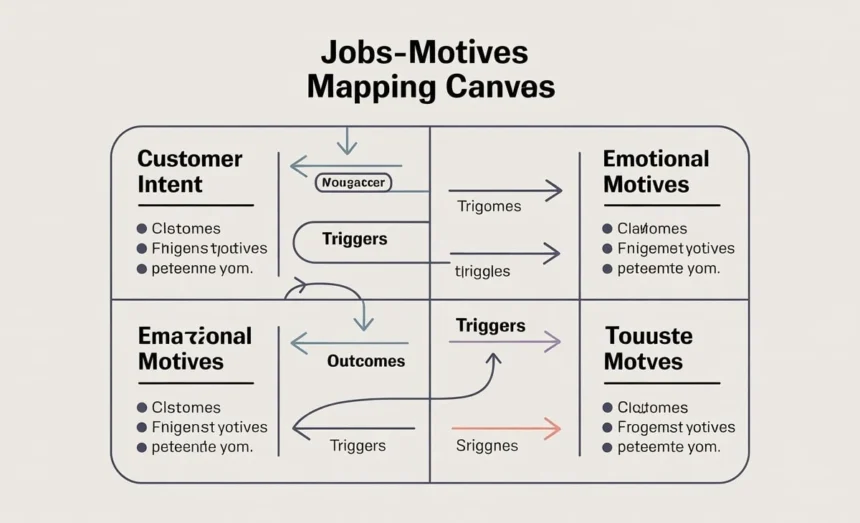Every purchase starts with a moment of intent. Someone doesn’t just buy a product; they decide it’s time to solve a problem, fulfill a desire, or feel a certain way. Most teams focus on what that person is trying to get done, yet overlook why the action happens now. That “why” is often emotional, tied to motives like reassurance, belonging, or control.
When paired with the functional logic of Jobs-to-Be-Done, these purchase motives reveal a more complete picture of customer behavior. The combination helps brands understand not just what people want, but what tips them into acting, whether clicking “buy,” subscribing, or switching.
In this guide, you’ll learn how to connect jobs and motives using a practical mapping canvas that links intent, emotion, and timing, helping teams design messages and experiences that feel relevant the moment decisions are made.
Understanding the Two Frameworks Behind the Canvas
To make the mapping canvas work, it helps to understand the two frameworks it brings together. One focuses on progress, the jobs people are trying to accomplish. The other focuses on emotion, the motives that spark action. Each captures a different part of how decisions are made. The sections below explain both and how they connect.
Understanding Jobs-to-Be-Done
The Jobs-to-Be-Done (JTBD) framework views people as “hiring” a product or service to make progress in a specific situation.
- Functional jobs: What the person wants to get done or improve.
- Emotional jobs: How they want to feel, or avoid feeling, while doing it.
- Social jobs: How they want others to see them as a result.
This lens surfaces the real outcomes people seek, not just the features they use. But when applied alone, it can describe what users want without explaining why they act at a given moment.
Understanding Purchase Motives
Motives are the emotional and situational forces that turn intention into action. They answer a simple but powerful question: Why now?
Common motives include:
- Reassurance: Avoiding risk or uncertainty.
- Aspiration: Seeking improvement or a higher status.
- Convenience: Reducing effort or complexity.
- Identity: Affirming a sense of self.
- Control: Regaining order or confidence.
Without understanding motives, the trigger behind the decision remains hidden.
Interplay Between Jobs and Motives
Jobs point to the direction of intent, what a person is trying to achieve. Motives provide the momentum that drives them to act.
Mapping only jobs may bring solutions that technically work but feel emotionally flat. Mapping only motives may generate interest but fail to deliver meaningful outcomes. The richest insight appears at their intersection, where functional needs meet emotional urgency.
What Happens When Jobs and Motives Don’t Connect
Even teams well-versed in one of these frameworks often struggle to predict or influence customer behavior because they work in silos. By keeping jobs and motives separate, three significant gaps appear, each with real business consequences.
-
Functional Focus Without Emotional Resonance
Products may meet a job statement convincingly, yet still feel irrelevant or uninspiring to the user. For example, A financial app may promise “organize my expenses” (job) but ignore the underlying motive of “I feel out of control and distracted”. The result? The feature is used, but not adopted or valued deeply; engagement drops.
-
Motive-Driven Messaging Without Job Fit
On the other side, marketing can hit strong emotional notes (“feel empowered”, “regain control”), but if the underlying product doesn’t map to a real job in the user’s context, trust erodes. The user may respond emotionally, but then quickly realize the outcome doesn’t match the promise.
-
Cross-Team Misalignment
When product leads prioritize job statements, UX teams optimize flows, and marketing emphasizes emotional hooks, without a shared framework linking job to motive, the user journey fragments. The result: inconsistent experience, mixed messages, and weaker outcomes.
Building the Jobs–Motives Mapping Canvas
To avoid these gaps, the Jobs–Motives Mapping Canvas offers a visual, structured tool that connects the user’s needed progress with the emotional urgency behind it. This section describes what the canvas is, how it’s structured, and how to build it step-by-step.
Structure of the Canvas
The canvas is built with four linked columns:
- Job: the progress the user seeks (functional + emotional + social).
- Motive: the reason the user cares and acts now.
- Trigger: the event, context, or signal that converts motive into action.
- Outcome: what success looks and feels like for the user (both functional relief and emotional payoff).
For example: Job = “Get healthy meals quickly after work”; Motive = “I feel guilty about unhealthy habits and want control”; Trigger = “I’ve had late nights all week and minimal cooking time”; Outcome = “I feel responsible, balanced, and in control of my routine”.
How to Build the Canvas Step by Step
- Identify core jobs: collect user stories, ethnographic or interview data that describe what progress users seek.
- Surface emotional motives: in those stories, listen for emotional, identity or situational cues showing why it matters now.
- Map context triggers: capture what shifts the user from “maybe someday” to “I’ll do this now”. Life changes, time pressure, fatigue, and deadlines all count.
- Define desired outcome: for each row, describe what “job + motive” answered looks like in user language, both functionally and emotionally.
- Validate and refine: test the hypotheses with users or behavioral data, and refine the canvas as more insight appears.
How the Canvas Bridges Strategy, UX, and Messaging
Product teams can use the canvas to prioritize features that serve high-impact jobs with strong motive alignment. Marketing teams can craft message flows that speak to motive + job at the right trigger moment.
UX and design can map flows and feedback loops that reduce friction and heighten motive-driven engagement. The canvas becomes a shared lens across disciplines.
How the Canvas Works in Real Scenarios
To illustrate how this framework works in practice, here are three composite examples drawn from different sectors.
Example 1: Meal Kit Subscription
- Job: “Get healthy meals quickly after work.”
- Motive: “I feel guilty about unhealthy eating and want more control over my habits.”
- Trigger: “Late work week and little energy to shop or cook.”
- Outcome: “I feel responsible, balanced, and in charge of my routine.”
Example 2: Fitness App Service
- Job: “Stay consistent with my workouts.”
- Motive: “I want to maintain my identity as someone disciplined and fit.”
- Trigger: “I’ve skipped workouts for two weeks and there’s an upcoming social event.”
- Outcome: “I feel confident, aligned with my image and back on track.”
Example 3: Financial Management Platform
- Job: “Organize my finances and reduce clutter.”
- Motive: “I’m anxious and need to feel stability and control.”
- Trigger: “An unexpected bill arrived, and I realized I’m behind on tracking spending.”
- Outcome: “I feel calmer, in control, and ready for what’s ahead.”
Putting the Canvas to Work Across Teams
Once the canvas is built, the work of embedding it into business operations begins. This section outlines how to operationalize, test, and maintain the model.
-
Integrating Into Product Roadmap and Feature Priorities
Use the canvas to identify features that serve key jobs with strong motive alignment. If a job has weak motive support, either reframe the messaging or reconsider investment. Map features to canvas rows to see which deliver real user-relevant momentum and which are cosmetic.
-
Designing Messaging and Experience Around Motive Triggers
Use canvas rows to craft aligned messaging: highlight job outcome and motive urgency within trigger context. In UX flows, introduce moments when the trigger is likely, reducing friction and guiding action. Onboarding flows should anticipate user motive states and offer direction accordingly.
-
Testing and Measuring Success
Measure outcomes such as conversion rate changes, drop-off at trigger points, and repeat engagement. According to the U.S. Bureau of Labor Statistics data, average consumer unit expenditures in the U.S. were $77,280 in 2023, up 5.9 % from 2022. Further, in 2023, the average U.S. household spent about $13,174 on transportation, making it the second-largest category after housing.
Use such benchmark data to contextualize motive-led experiments (for example: if motive “control of finances” triggers feature use, you might benchmark engagement relative to spending trends). Embed motive hypotheses into A/B or multivariate tests: “Does emphasizing motive X increase activation by Y %?” Revisit the canvas regularly to reflect market or behavioral shifts.
-
Maintaining and Growing the Canvas
Motives may shift as economic conditions, competition, and culture grow. The canvas should be a living document: update it when new insight or behavior appears. Cross-team review (product, UX, marketing) should happen at regular intervals so the canvas remains referenced and useful, not filed away.
Where is Decision-Mapping Headed Next?
As consumer behavior, analytics, and personalization capabilities grow, the way we make decisions will grow too. This section points to developments to watch that could affect how the canvas is used.
-
Automated Detection of Motive Signals
Developing analytics tools is already beginning to surface motive cues from language, timing, and behavior. This means future versions of the canvas may update dynamically, with motive states inferred in real time rather than only via manual research.
-
Cross-Functional Shared Frameworks
The canvas has the potential to become a shared artefact across product, design, marketing, and analytics teams. With a common language linking job + motive + trigger, silos are reduced and coherence in the user-facing strategy improves.
-
Linking Job-Motive Maps to Personalization Engines
In the future, mapping rows may feed directly into personalization logic: showing messaging, features, or prompts that match a user’s current job + motive state and trigger context. This could enable timely, relevant interventions and improved retention.
Conclusion
The Jobs–Motives Mapping Canvas brings clarity to why people act, not just what they want to achieve. Linking progress-based goals with emotional drivers helps teams design experiences that feel relevant and well-timed.
When product, design, and marketing teams work from the same canvas, they move beyond surface insights to a shared understanding of customer intent. The result is communication and decision-making that resonate more deeply, meeting users at the exact point where purpose meets motivation.







